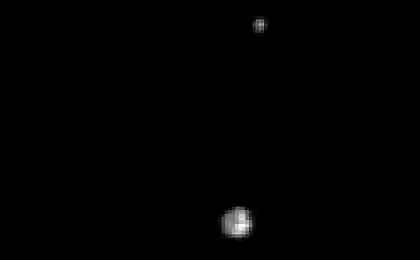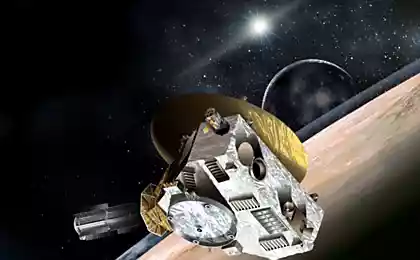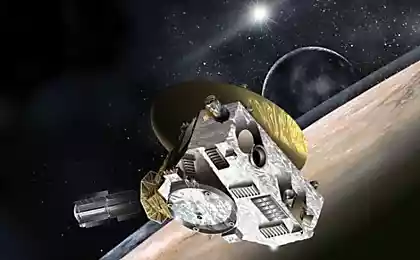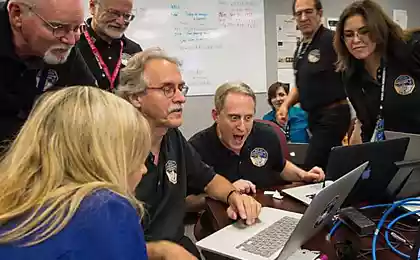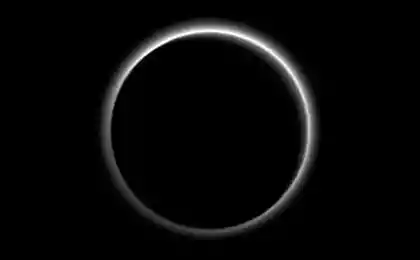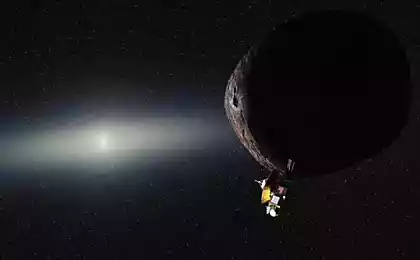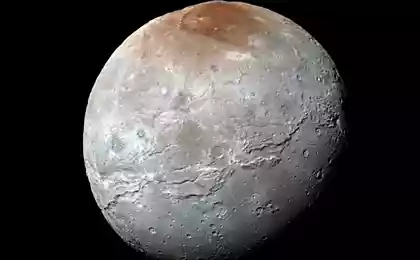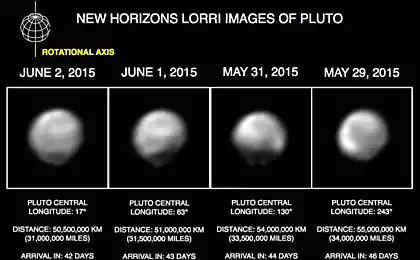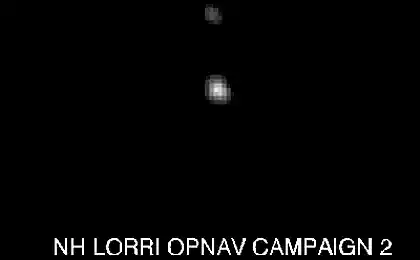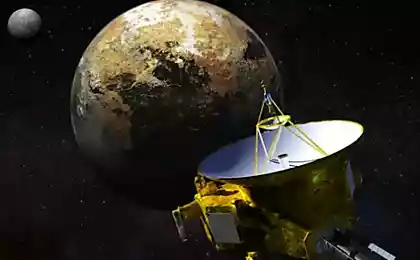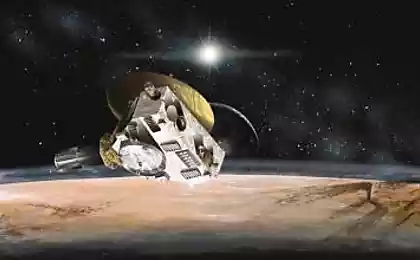1058
More pictures of Pluto, detailed and fascinating
... And other data from New Horizons.
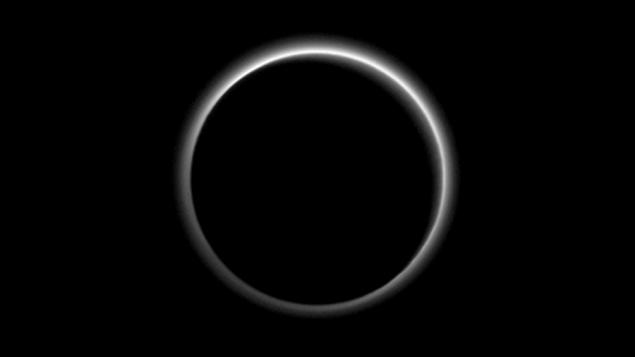
Image Source: NASA / Johns Hopkins University Applied Physics Laboratory / Southwest Research Institute i>
Just over an hour ago The regular press conference of NASA, which New Horizons team shared new discoveries and, of course, the new beautiful pictures. Details - under the cut.
Atmosphere h4> Image in the beginning of the article was lifted probe about 7 hours after the moment of closest approach to Pluto, while coating the dwarf planet of the Sun disc. For the first time in history it was a visual confirmation of the existence of Pluto's atmosphere - despite the fact that its existence has been known since the 80s by circumstantial evidence, its images were obtained only this week.
Photos surface h4>

Image Source: NASA / Johns Hopkins University Applied Physics Laboratory / Southwest Research Institute i>
Just over an hour ago The regular press conference of NASA, which New Horizons team shared new discoveries and, of course, the new beautiful pictures. Details - under the cut.
Atmosphere h4> Image in the beginning of the article was lifted probe about 7 hours after the moment of closest approach to Pluto, while coating the dwarf planet of the Sun disc. For the first time in history it was a visual confirmation of the existence of Pluto's atmosphere - despite the fact that its existence has been known since the 80s by circumstantial evidence, its images were obtained only this week.
Examining this image, experts in the atmosphere in the team New Horizons found in the image traces of haze or mist (Eng. haze i>) in the atmosphere of Pluto. This haze extends to a height of 100 miles (~ 160 km) from the surface.
Atmospheric pressure near the surface was much lower than previously thought (almost 2 times). Moreover, the chart below (values in millibars), shows a sharp drop in atmospheric pressure over the last couple of years, although previously observed a pronounced upward trend in atmospheric pressure (in the accuracy of the earlier data, scientists have no doubt, even though they had received from the Earth) . As a working hypothesis has been suggested that this - clear evidence of thinning of the atmosphere of Pluto as it begins to move away from the sun, even though such a drastic change in trend all puzzled.
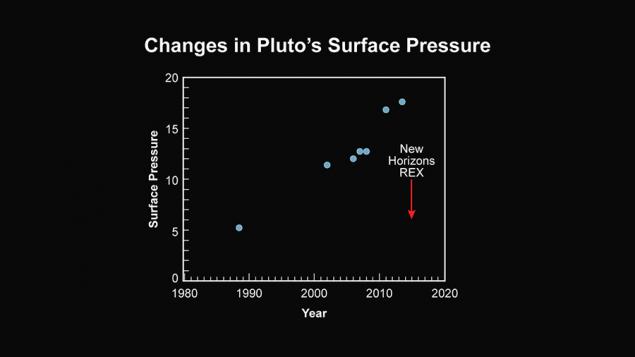
Image Source: NASA / Johns Hopkins University Applied Physics Laboratory / Southwest Research Institute i>
But Charon , apparently, can not boast of the atmosphere. New Horizons flew in his shadow (to take a picture, similar to Pluto snapshot at the beginning of the article), but Alice spectrometer on board the detection of nearly instant drop in radiation levels. Analogous measurements for Pluto received a week ago, showed a gradual decrease in brightness smooth , indicating the presence of an atmosphere.

Image Source: NASA / Johns Hopkins University Applied Physics Laboratory / Southwest Research Institute i>
According to the Head of Mission Alan Stern, it was also obtained a picture of Charon shortly before entering his shadow, which looks like an ordinary satellite sickle without rings around - and if there is an atmosphere of Charon, it is too thin, so that it can be detected in the received at date data. Said picture came with injuries, so today it was not shown.
Photos surface h4> 
Image Source: NASA / Johns Hopkins University Applied Physics Laboratory / Southwest Research Institute i>
The image above - a new overall picture of Pluto (now in an even higher resolution than before!), Made up of 4 separate photographs taken while approaching the black and white camera LORRI, combined with the color data from the camera on the device Ralph MVIC. Resolution is twice the resolution of previous similar picture has become famous; here it is possible to discern details of up to 2.2 km. According to Alan Stern, all received at present photographic evidence suggests that Pluto is incredibly close to the ideal spherical shape, which may be an indication that after a hypothetical collision with another object that spawned satellite system, Pluto for some time spinning extremely quickly, before tidal forces slowed down and synchronized it with the Charon.
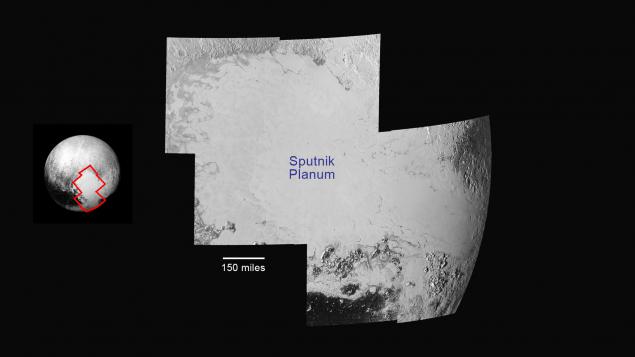
Image Source: NASA / Johns Hopkins University Applied Physics Laboratory / Southwest Research Institute i>
New Horizons continues to send highly detailed photographic data from the moment of its closest flyby of Pluto, and now available for 7 frames that make up the mosaic above - it shows a portion of the surface near the "heart", which New Horizons team calls the "region Tombo" ( and the icy plain in the center of the heart - the plateau satellite). Pictures rotated about 45 degrees counterclockwise relative to their position on the general image of Pluto (so north is to the left, top, east - on the right-top).
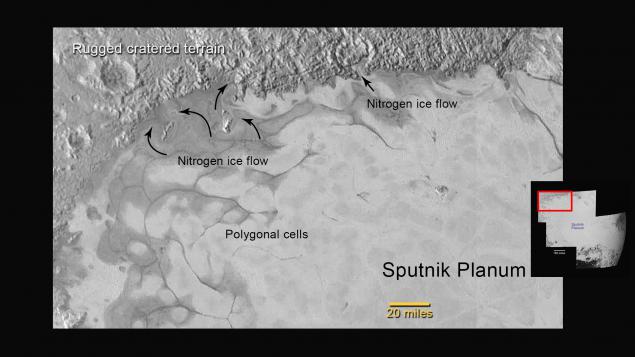
Source image: NASA / Johns Hopkins University Applied Physics Laboratory / Southwest Research Institute i>
In the northern part of the photographed area is visible boundary between icy plateaus and rough terrain, strewn with craters and, most likely, traces of erosion. The ice plateau Sputnik, as the data from the spectrometer, Alice, composed of methane, nitrogen and carbon monoxide (CO), in the upper left portion of the image, you can see signs of a slow flow of nitrogen is extremely viscous ice that William MacKinnon, one of the researchers mission New Horizons, compares with a slow "trend" of glaciers on Earth. According to him, such movement of the ice, most likely caused by the heat emanating from the interior of Pluto, rather than the solar activity. In the picture can also be seen how the ice for the enveloping contour of the "islands" dotted with rough surface cracks, as well as the glacier, half-filled impact crater (top of the image, just right of center).
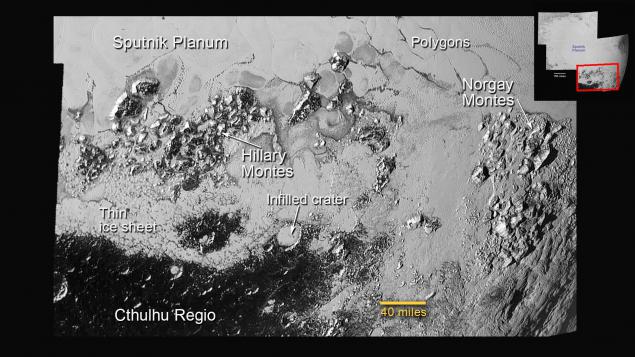
Source image: NASA / Johns Hopkins University Applied Physics Laboratory / Southwest Research Institute i>
In the southern part of the mosaic shown in the illustration above, you can watch the second detected on Pluto mountain range (in the left part of the photo), which New Horizons team has given the informal name "Mount Hillary," named Edmund Hillary, to climb Mount Everest in a pair with Tenzing Norgay , the name given to the first mountain range (in the photo on the right).
Despite the fact that, in accordance with the original plan data to Earth, the next time sending pictures is scheduled for mid-September, Alan Stern said that in this period will be given a little more photographic data. Anyway, a press conference New Horizons will be scheduled every Friday, at least at first.
Source: geektimes.ru/post/259300/
20 signs that you are doing well in life, even if we do not feel it
Mark Zuckerberg has overtaken IKEA founder Ingvar Kamprad in the ranking of billionaires Bloomberg






